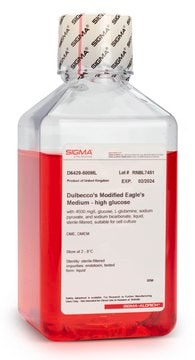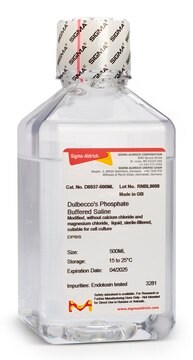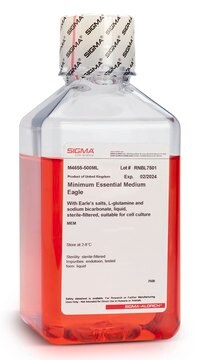R8758
Medio RPMI-1640
With ʟ-glutamine, sodium bicarbonate, liquid, sterile-filtered, suitable for cell culture
Sinónimos:
Roswell Park Memorial Institute 1640 medium
About This Item
Productos recomendados
Nombre del producto
Medio RPMI-1640, With L-glutamine and sodium bicarbonate, liquid, sterile-filtered, suitable for cell culture
Nivel de calidad
esterilidad
sterile-filtered
Formulario
liquid
técnicas
cell culture | mammalian: suitable
impurezas
endotoxin, tested
componentes
NaHCO3: yes
phenol red: yes
sodium pyruvate: no
HEPES: no
L-glutamine: yes
Condiciones de envío
ambient
temp. de almacenamiento
2-8°C
¿Está buscando productos similares? Visita Guía de comparación de productos
Descripción general
Aplicación
Opcional
Producto relacionado
también adquirido normalmente con este producto
Código de clase de almacenamiento
12 - Non Combustible Liquids
Clase de riesgo para el agua (WGK)
WGK 1
Punto de inflamabilidad (°F)
Not applicable
Punto de inflamabilidad (°C)
Not applicable
Elija entre una de las versiones más recientes:
¿Ya tiene este producto?
Encuentre la documentación para los productos que ha comprado recientemente en la Biblioteca de documentos.
Los clientes también vieron
Protocolos
Preparation for biodegradable nanoparticles and their use in transfection protocols .
Preparation for biodegradable nanoparticles and their use in transfection protocols .
Preparation for biodegradable nanoparticles and their use in transfection protocols .
Preparation for biodegradable nanoparticles and their use in transfection protocols .
Contenido relacionado
Learn how to use our cell culture tested, ready-to-use MilliShot™ single dose antibiotic solutions, conveniently packaged in one-time use vials.
Learn how to use our cell culture tested, ready-to-use MilliShot™ single dose antibiotic solutions, conveniently packaged in one-time use vials.
Learn how to use our cell culture tested, ready-to-use MilliShot™ single dose antibiotic solutions, conveniently packaged in one-time use vials.
Learn how to use our cell culture tested, ready-to-use MilliShot™ single dose antibiotic solutions, conveniently packaged in one-time use vials.
Nuestro equipo de científicos tiene experiencia en todas las áreas de investigación: Ciencias de la vida, Ciencia de los materiales, Síntesis química, Cromatografía, Analítica y muchas otras.
Póngase en contacto con el Servicio técnico








